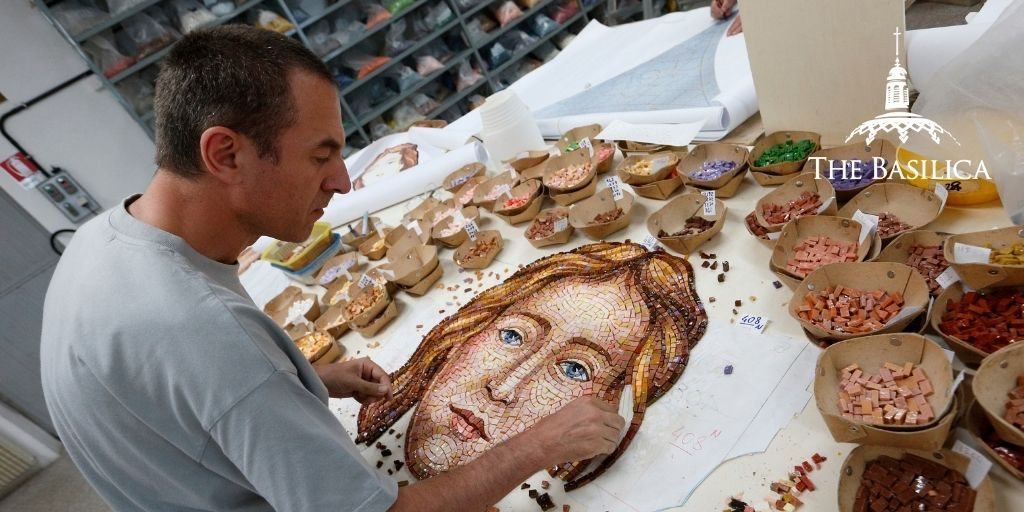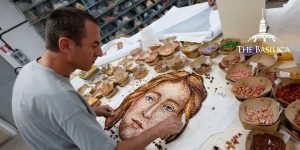
This year, we celebrate the Solemnity of the Most Holy Trinity on May 30, reflecting on one of the most powerful mysteries of our faith. Since the early 14th century, the faithful have observed this holy day in honor of the triune nature of our God. Each of the three distinct persons in the Godhead plays a unique role in the story of divine creation and redemption, in a manner mysterious yet harmonious.
The Basilica honors the Trinity in a very special way with the Trinity Dome, the largest and final dome mosaic to be completed at the National Shrine. Today, we are offering you an inside look into the making of this “crowning jewel” of the National Shrine.
The First Step: Sketching and Enlarging the Design
Our journey starts in northern Italy, where artists created a design featuring the Holy Trinity, the Immaculate Conception, and a litany of North American saints. Once the image was approved by the National Shrine’s iconography committee, the artists began the process of enlarging it by hand. After the image was enlarged to a collection of full-scale drawings, the design artists divided it into numbered sections.
Building Blocks: Venetian Glass
The full-scale sketches of the dome were passed along to the mosaic artists, who began the process of color-coding mosaic tiles by hand, delineating more than one thousand variations of colorful Venetian glass.
This Venetian glass is handmade by only two companies in the world. Each piece is initially shaped one at a time using a hammer and chisel. Since every tile is created for a specific place on the mosaic, if the tile breaks incorrectly while being chiseled, the artisan must take another piece of glass and begin the process again.
You can watch the video below to see an artist at work creating the face of Mary.
Mosaic Installation: The Indirect Method
The artisans at Travisanutto Giovanni company fabricated the mosaic using the reverse – or indirect – method. Invented in Italy in the late 19th century, this method allows for the creation of mosaics of a much greater scale, in a more reasonable timeframe, and at a more reasonable cost. The mosaic is created in reverse, with the glass tiles temporarily affixed right side down on large sections of paper. The adhesion is achieved using a paste made from flour and water. This process ensures that once every section of mosaic is delivered to the site for installation, artisans will cement the sections to the surface of the dome according to precise mapping. The paste is then scrubbed off to expose the mosaic tiles.
This is an incredible advancement from the prior method, known as the direct method, in which the glass tiles were directly cemented to a surface right side up and piece by piece, rather than section by section, taking at least three times as long to create the finished art piece.
Artisans laid out each of the 30,000 sections of the Trinity Dome mosaic on the floor of a large warehouse in Italy, arranging each figure in full before packaging it into boxes for shipment. Over 24 tons of mosaic tiles were packed into wooden crates and shipped by air and boat from Italy to Washington, D.C. to be installed.
Installation Time!

Once the wooden crates arrived at the Basilica, a construction elevator lifted them and delivered the different sections to their places on the thirteen floors of scaffolding. In order to prep the inside of the dome for the installation, workers had to strip all the original plaster off the walls of the dome. Then, over the course of weeks, the tile pieces were attached to the ceiling.
The Trinity Dome
The Trinity Dome took over two years to complete from start to finish. Made with 14 million tesserae, it covers a total of 18,299 square feet. Pictured in the mosaic are the Blessed Trinity, the Immaculate Conception, 18 saints, two archangels, four choir angels, and four evangelists. It is the third dome on the path to the Christ in Majesty mosaic and was dedicated on December 8, 2017.
Behind the Scenes: Slideshow
Click the arrows to navigate.

